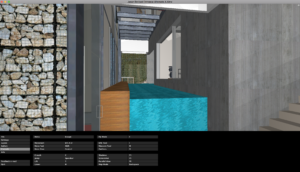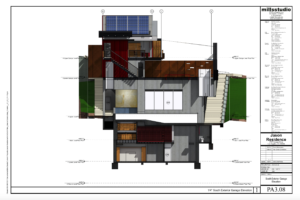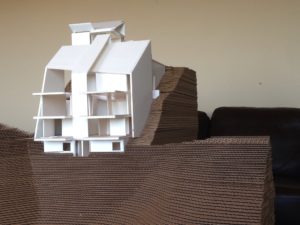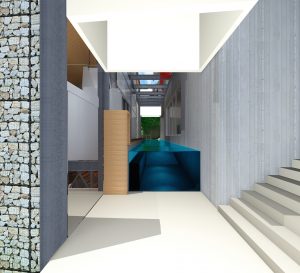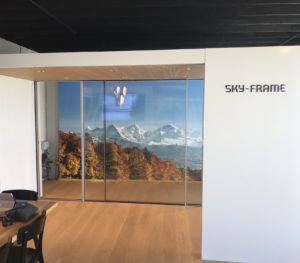God created paper for the purpose of drawing architecture on it. Everything else is, at least for me, an abuse of paper.
~ Alvar Aalto
Design Documentation
There are many and varied reasons for documenting the design of the DTS Project House:
- Documentation of existing site conditions
- Documentation for visualization of design
- Documentation to expose design issues not readily apparent
- Documentation to present design to client
- Documentation to convince client of design
- Documentation for consultants
- Documentation to determine building’s energy performance
- Documentation to expose conflicts in building components
- Documentation to obtain permits and approvals
- Documentation to show how design is constructed
- Documentation to determine quantities to be ordered
- Documentation to solicit interest from vendors and contractors
- Documentation to record precisely what was built
- Documentation to make the project public
- Documentation to meet LEED requirements
The varied reasons for documentation lead to varied types of documentation from photography, to video, to 2D drawings, to 3D models, to physical models and mock-ups.
SOFTWARE
Although there are good arguments that architecture has not been made better by the almost exclusive use of computer software to produce project documentation, the fact that architecture is now such a collaborative endeavor the computer is now a necessity to link all of the disparate project partners. The choice of software is made based upon ones attitudes towards documentation and working methods. The choice then in turn affects the final choices of documentation and working methods. mills studio’s first computer was an Apple SE30 in the eighties so software that best integrated with the Apple Macintosh was always the first choice. ArchiCAD was an early choice over AutoCAD because of its ability to produce 3D models on the Apple Macintosh.
ArchiCAD
Graphisoft’s ArchiCAD software was used to produce both 2D and 3D documentation for the DTS Project House. Gábor Bojár, a Hungarian physicist, began development of ArchiCAD in 1982 for use on the Apple Macintosh. He released Radar CH his first version of what was to become ArchiCAD in 1984 for the Apple Lisa Operating System. This makes ArchiCAD the first CAD program capable of producing both 2D and 3D on a personal computer and the first to release BIM software in 1987 for use on a personal computer.
As defined by the US National Building Information Model Standard Project Committee, Building Information Modeling (BIM) is a digital representation of physical and functional characteristics of a facility. The Building Information Model provides a digital description of every aspect of the built asset that allows one to create and manage all of the information on a project before, during, and after construction.
ArchiCAD can import and export DWG, DXF and IFC and BCF files among others. ArchiCAD is also capable of exporting 3D models in the Sketchup format. Graphisoft was one of the founders of the Open BIM concept, which supports 3D BIM data exchange between the different design disciplines on open-source platforms.
ArchiCAD can also export the 3D model and its corresponding 2D drawings to BIMx format which can be viewed on a number of desktop and mobile platforms with native BIMx viewers. ArchiCAD 9 offered some of the BIMx capabilities and ArchiCAD 15 was the first to include the named BIMx application.
BIMx
BIMx is a Graphisoft software for desktop and mobile devices that allows the 3D model and 2D drawings to be viewed without the use of Archicad. The BIMx model can be experienced in an interactive manner similar to video games. The client, consultants, and vendors can all access a simplified 3D model of the project on Apple iOS, Android, Apple OSX or Microsoft windows operating systems. The free BIMx App for iOS and Android can be downloaded from the iTunes App Store or a BIMx Desktop application can be downloaded directly rom Graphisoft to access the 3D model and perform virtual walk-thrus. A BIMx PRO App can be purchased to display not only the 3D model but also the 2D documents.
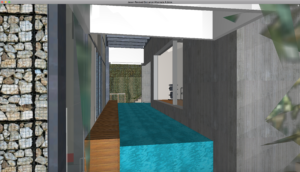
3D MODEL
The most important design and documentation tool for the DTS Project House is the 3D model built in ArchiCAD. Most conceptual design was done in the three dimensional model to provide a full visual understanding of how design options and decisions affected multiple levels, of how the building sits on the sloped hillside, and the buildings impact at different scales and from different perspectives. Screen shots of the 3D model provide a very quick way to freeze options for review and evaluation.
Screen shots of the 3D model and its export to BIMx files were the chief method of showing the design options to the client. The client was able to do download free apps and do full fly-throughs of the 3D model on devices from an iPhone, to an iPad, to a MacBook, to an IMac, to an Android phone at every stage of design. It was possible to direct the client to specific locations in the model using the Gallery function of the BIMx Model.
2D documents were created from the 3D Model. The ability to layer all aspects of the construction provided the ability to develop and evaluate the sequencing of construction, such as the exposed concrete, and how the sequencing might affect the design. Layering also allows for isolating building components and details in order to design and evaluate as an independent concepual part and then quickly placing in context. The physical construction of the 3D Model forces decisions regarding the minutest details, material thicknesses and alignments, and specification of every building component.
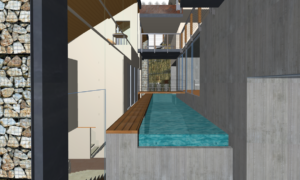
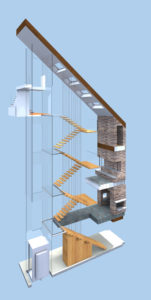
DRAWINGS
2D drawings are chiefly used to explain how the DTS Project House is constructed. This ranges from the working out of design and construction details to how the design is implemented in the construction process to gaining permits and approvals. The building design details are integral to and indistinguishable from the building’s construction details so much of the working out of design details was done in 2D enlarged plan, section, and elevation and then transferred to the 3D model for evaluation in full context.
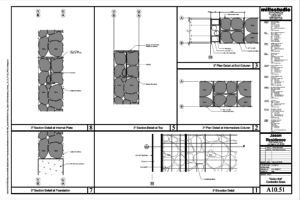
MODELS
The best way to feel and conceptualize the contours of the site’s slopes is the combination of walking the slopes and the physical making of a contour model. The body’s direct experience of the site tells one portion of the site’s story and the hand making of a physical contour model tells another portion. Models for the DTS Project House are almost wholly design tools rather than documentation of the finished design. Because of the physical relation between the human body and the size of the models the models serve to conceptualize how the building interacts with the site and the conceptual puzzle of the excavation and concrete sequencing. Thus the most important use of models was to investigate how the building sits on and in the severely sloped lot and the required excavations and sequencing to make the construction possible. Once determined in three dimensions the sequencing was documented in the 3D model and renderings.

RENDERINGS
Renderings serve multiple purposes in developing the DTS Project House. They were a design tool to test and evaluate design options, evaluate materials and design details in context, a way of showing the client the design options and affects of design decisions, and as a conceptual representation of the finished product. Renderings were also used to develop and explain Construction sequencing. Three dimensional renderings were created in the Artlantis Render application from the ArchiCAD 3D Model along with Photo Shop.
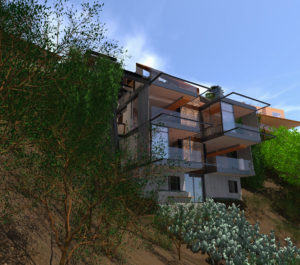
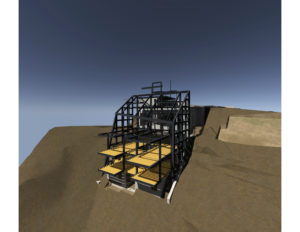
MOCK-UPS
The visual and phenomenological impact of some materials, components, and assemblies are so dependent upon experiencing their actual sizes in relation to the human body and environment that full size mock-ups are the only way to evaluate contemplated design decisions and make useful judgements. Exposed concrete, door and window systems, railing systems, exterior shades, gabions, and metal siding are among the elements in the DTS Project House that required full scale mock-ups. Many manufacturers of components, like doors and windows, already have full scale mock-ups of their products which can be experienced and used to evaluate real-world impacts. Other assemblies which require the installation of a combination of manufacturer’s components have to be mocked-up by sub-contractors. There are also assemblies, such as the exposed concrete and gabions, whose experience is so dependent upon the unique site conditions and environmental factors that they must be mocked-up and experienced on the DTS Project House site.
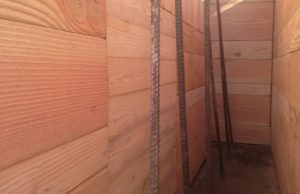
The pencil and computer are, if left to their own devices, equally dumb and only as good as the person driving them.
~ Norman Foster
